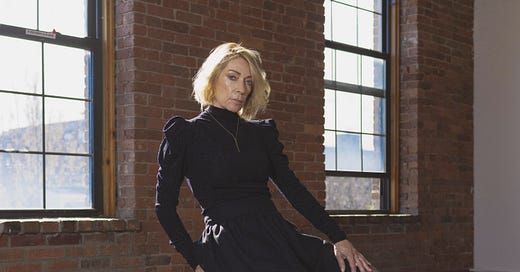A constant presence in Kim Gordon’s art is the anti-elitist ideologies found in the Fluxus and Dadaist movements of the 20th century. Throughout her career, Gordon has continually embodied the ethos of these movements, dismantling the prestigious and delimiting definitions of art. She’s collaborated with Fluxus legend Yoko Ono and made an experimental live album that relies upon the automatic process of improvisation. From Sonic Youth through to Body/Head to her solo oeuvre, Gordon’s musical output has always fallen within the realms of Neo-Dadaist noise rock, pushing the boundaries of what music can and should sound like.
In her autobiography Girl In Band, Gordon describes how “Fluxus explored art as a process, using the viewer, or the audience, to complete the work. It asked, What can art be?” With her latest single ‘BYE BYE’, Gordon experiments with this concept, incorporating some of the earliest and yet, most impactful concepts of Dadaism and Fluxus.
Take these lyrics:
“Milk thistle, calcium, high-rise, boot cut, Advil, black jeans
Blue jeans, cardigan, purse, passport, pajamas, silk.”
At first listen, they may strike as a sequence of unrelated nouns, a process of automatic writing. A second listen might suggest a shopping list; but the third reveals the track as a to-do list in preparation for a holiday, from what arrangements need to be made to what to pack.
Gordon’s lyricism on this track is similar to the concept of ‘readymades’, a radical artistic proposition innovated by Marcel Duchamp. In his physical art, Duchamp would take found, everyday objects and present them as art; a coatrack, a wine bottle holder, the famous urinal. Duchamp said that his “idea was to choose an object that wouldn't attract me, either by its beauty or by its ugliness. To find a point of indifference in my looking at it, you see.”
‘BYE BYE’ invites us to view the mundanity and neutrality of this ‘found’ lyricism through a new light. What should be an unemotive catalogue is imbued by the personal implications of these items. It is simultaneously revealing of Gordon (or the speaker of Gordon’s list - the line ‘for a killer’ is the only suggestion that this list is anything but ordinary) and of the audience in what they derive from it.
It seems only right to think of Joan Didion at this time, whose own packing list has a lasting iconic hold on the cultural psyche. Didion’s list is a revealing insight into her personal self. Though she goes on to unpack what these items divulge about her, the ‘anonymity’ of her wardrobe and the apparent lack of materialism is evidence to us of who she is. From this list, we create an image of her character, her specific neuroses, her primary drive.
And thus, we do the same with ‘BYE BYE’. Our interaction elevates the pieces original purpose to something closer to a diary or a psychotherapists report.
But it is primarily through Gordon’s performance that these lyrics to take on new value. The cadence of Gordon’s delivery produces a sonic value in the language that is absent in its visual format; one can imagine it re-produced onto the page as an e.e cummings poem, ‘blackjeans, bluejeans, car-di-gan, purse, pass-port, pajaaamaaaas. SILK.’ She is inventive with her syllabic pronunciations, allowing us to hear every step of a words construction. Her choice of pause length breaks the rolling intonation of bullet points with discordant stops and starts, implying a new set of punctuation. Much like Duchamps ‘readymades’, the to-do list is heightened by is presentation. Were Duchamp’s urinal not entitled ‘Fountain’ and boldly placed into an art gallery, we might never have had such a reaction to it as a piece. We experience these found pieces differently because of the contexts and ways in which it is delivered to us.
Where these lyrics really excite is in the suggestiveness of their positioning. The to-do list doesn’t seem to follow a necessary order, which suggests either a randomised construction or a re-ordering process (perhaps the Dadaist cut-and-stick approach). This illogical form allows us as the listener to interact with the lyrics and form associations, thereby completing the work ourselves.
One such found relationship is in the final lines sequential listing of ‘vibrator. teaser’. In the form of their physical selves - that is them as objects - they are unrelated. Yet, the sexual purpose of the former confounds the linguistic make-up of the latter. As such, ‘teaser’ is disassociated from its cosmetic purpose and finds double meaning in its place next to ‘vibrator’.
All of this is reinforced by the songs experimental composition. The opening and continuous beat of the track has been likened to Playboi Carti, which is at odds with the electronic and guitar heavy soundscape accompanying it. Cacophonic breakdowns bridge the verses, interweaving harsh industrial distortions and static fuzz. With Gordon’s drawling voice, the overall result finds balance between a devastating ease of cool and brash unpredictability.
It’s refreshing to experience music that challenges the distinctions and definitions of art, that implicitly encourages its listener to change their perspectives and the way they interact with the everyday life surrounding them. Hopefully, Gordon’s upcoming album ‘The Collective’ pushes even further with this and continues her lifelong resistance to boundaries.





